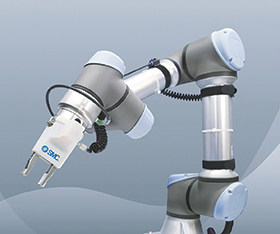

Once industry looks beyond the myths about cobots, it will begin to reap the benefits of what they really bring to the shop floor. For example, assisted by advances in edge computing, collaborative robots do not require the complex set-up of traditional industrial robots. These used to require at least a week of training, but some cobot manufacturers now make it possible to get up and running in as little as a half-hour.
The economic benefits they bring to manufacturing are also appealing when compared to robots, as they require a much lower initial investment and a highly reduced implementation cost. By some estimates, payback time for a typical cobot is between one and two years and can be as short as six months. These two benefits make cobots an attractive investment, but what sets them apart is the flexibility they provide.
Flexibility – the cobots´ answer to ever-changing market demands
Cobots adapt easily to multiple applications, unlike traditional robots that generally are designed to perform just one task. Their light weight and more compact dimensions, coupled with the easier reprogramming, translate into a high level of mobility so they can be placed easily where the production process demands. Cobots make it easy to automate, even for short production runs and to change lines frequently.
Their contribution to versatility is as varied as each process reality. For example, companies not working on a 24/7 workflow can set up cobots to load machines that run at night while the factory is closed. By morning, when it reopens, a production run has been completed. In other cases, cobots can assist workers when the task is demanding, dangerous, or just tedious, freeing time for the workers to perform more productive and creative duties.
The safety issue
Designed to work alongside their human counterparts, with proper risk assessment, cobots may not require confining cages or cumbersome safety guarding. Christoph Ryll, a cobot specialist who is collaborating with SMC to develop practical safety solutions, describes what would be the final purpose: working together, humans and cobots can achieve a higher efficiency than either could alone. However, safety is still an issue, and 95% of cobots are still today confined by cages and not truly collaborative.
End effectors – a matter of symbiosis
End effectors, primarily in the form of grippers, enable the business end of the cobot to handle and manipulate parts with a wide variety of shapes, sizes and materials. The flexibility of adapting a cobot to many different applications is a major benefit, as long as it is easy to change the gripper. For instance, a cobot used to drive screws on an assembly line has to be easily refitted with a different end effector when reconfigured for a pick-and-place application.
Machine builders or integrators should communicate closely with end users in order to ensure the success of the union. The gripping technology should be able to adjust perfectly to the specific needs of the task. As important as it is to select the right cobot, it’s equally vital to choose the correct end tool, capable of being customised to meet the specific requirements of the task, such as location of pick, maximum allowable force, weight profile of the part, its composition and shape.
The best gripper depends on the task
SMC have developed solutions designed to work with all robots and cobots on the market.
Pneumatic grippers are well suited for general pick-and-place applications. Air-operated solutions provide high force, speed and operating frequency. If none of those parameters need to be controlled or precise, a pneumatic gripper is the best solution.
Vacuum grippers generally are in the form of suction pads. Suction holding is normally recommended for moving and transferring delicate or flimsy workpieces.
Electric grippers are best for control of the position, force or speed. They allow partial closing and opening, for example, which makes them ideal for handling delicate pieces such as printed circuit boards.
Magnetic grippers are for those applications where suction pads and grippers will not perform optimally due to uneven or porous surfaces.
SMC offers all the different gripping technologies and develops plug-and-play grippers and gripper systems for all cobot and robot suppliers. They are based on the concepts of energy efficiency and performance, with special focus on size and weight optimisation.
However, where the company can really make a difference is in its capacity to implement a 360º, such as electric solutions that assist cobot mobility combined with the technical support to customise automation solutions that adapt perfectly to production processes and ensure optimum flexibility.
| Tel: | +27 11 100 5866 |
| Email: | [email protected] |
| www: | www.smcza.co.za |
| Articles: | More information and articles about SMC Corporation South Africa |

© Technews Publishing (Pty) Ltd | All Rights Reserved